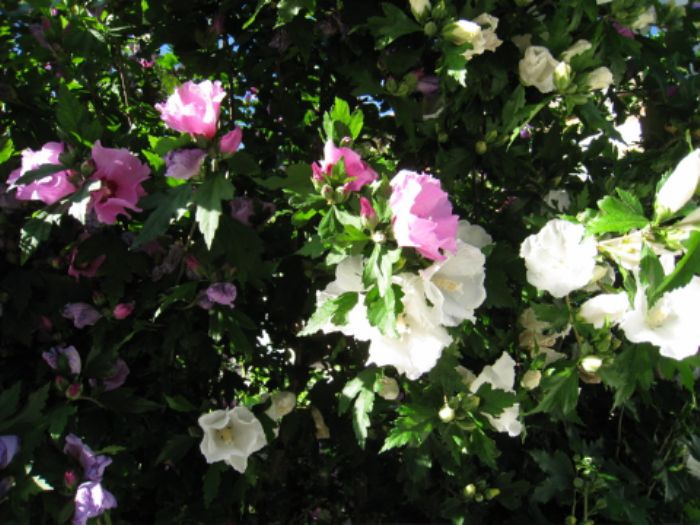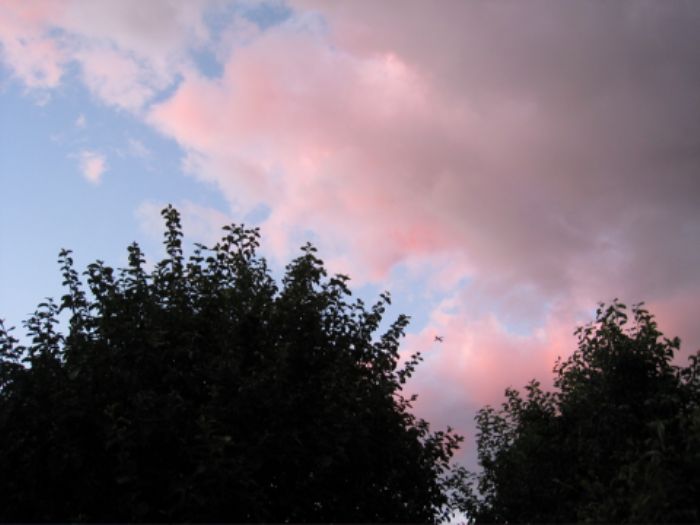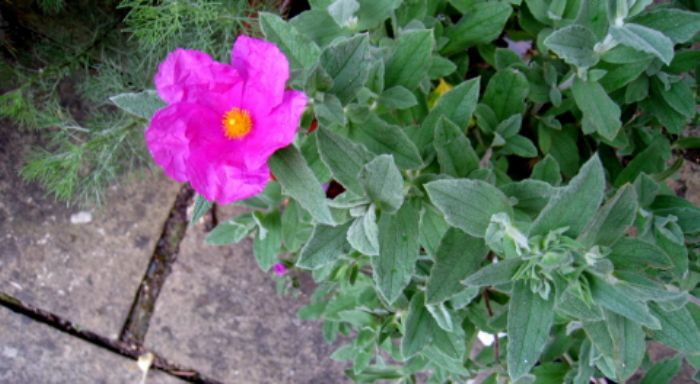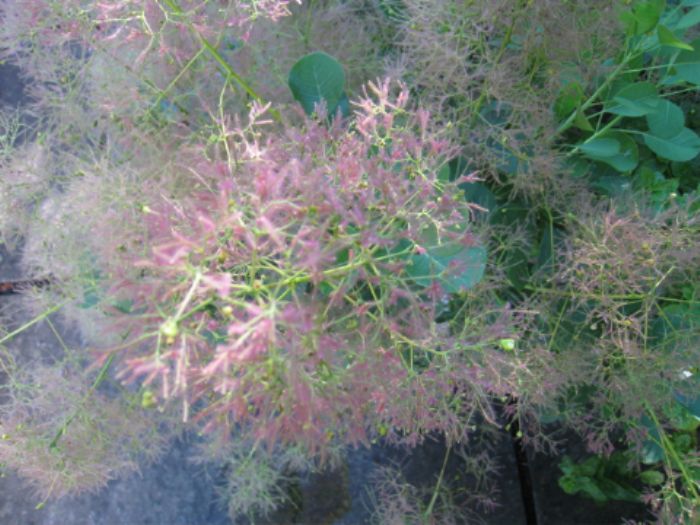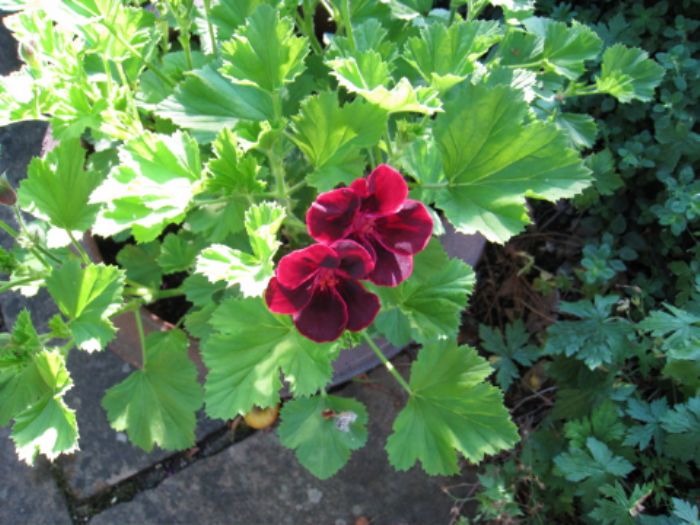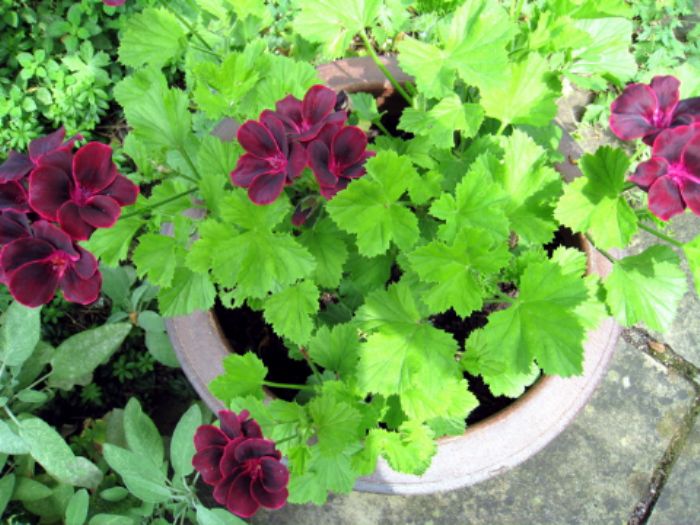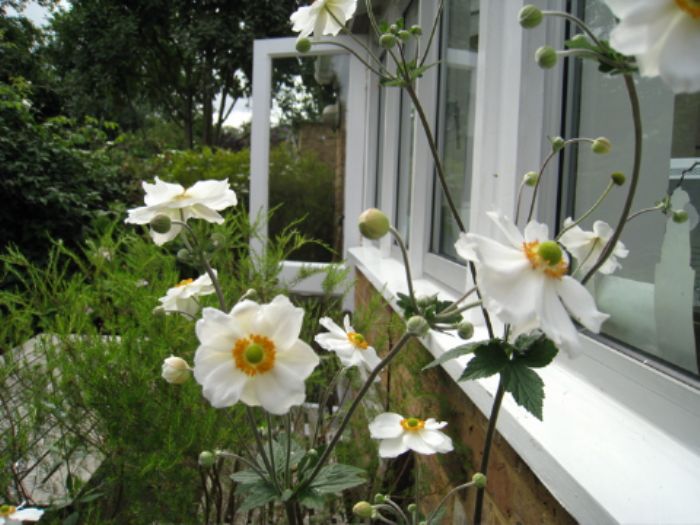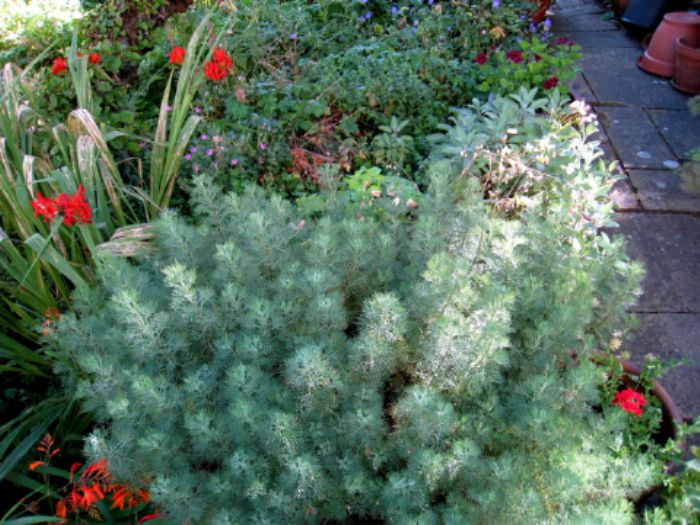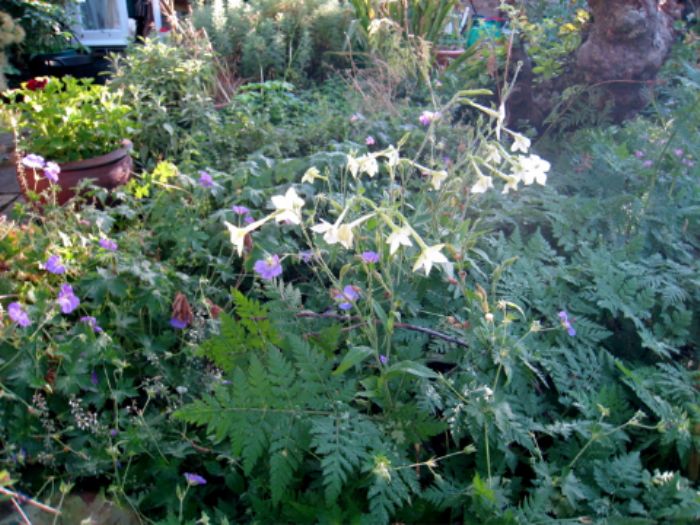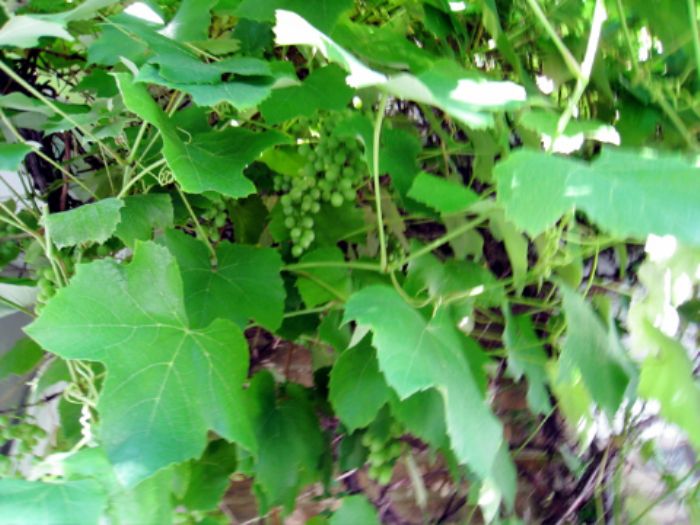We inherited a rampantly overgrown garden when we moved here in the early 1970s. The old man who owned it before us had grown tomatoes and there were two greenhouses, which took up a lot of the space. They were quite ramshackle, so we took one down altogether and replaced the other, as I also planned to grow tomatoes. Somebody gave us a black mulberry tree, which sadly came to grief in the big storm some years later. I put in a grapevine by the front door which had no fruit for seven years and since then it’s been like a mini vineyard, heavy with bunches of grapes every summer. They turn a rosé colour when ripe and taste of strawberries.
The garden has walls on all sides. These came in especially useful when we kept rabbits and allowed them to run around freely. Although they managed to dig a large warren while unsupervised, they couldn’t dig under the walls. They escaped from the clutches of the neighbouring cats by scarpering down the holes they had dug. We were sad when they died but I was thrilled to find I still had some of my original plants, which began to flourish again, with nobody around to eat them.
We’ve had foxes with their cubs sitting on the lawn, rats in the compost heap, frogs and toads, fieldmice in the ivy, all in a space which has not been sprayed with any pesticides for a very long time. The slugs and snails are kept down to some extent by the many birds, who also eat our crabapples and figs. A greedy lot, with an ever beady eye for the main chance.
Recently, we have had a plague of green parakeets, which vie for supremacy with the ever present aeroplanes in the skies above…. they haven’t, as yet, knocked out the swallows and house martins and we have always had wrens nesting, deep amongst a creeper which protects them from the weather and from marauding cats. We usually have a robin or two in the Spring. They are very bold and independent creatures and one of them would insist on sitting on the kitchen windowsill and peering in. My mother loved robins and so I thought it was probably her, wondering how I was getting along, frustrated that she wasn’t able tell me the right way to make a cake. Or that the floor needed mopping.
There has been a succession of vicious squirrels which patrol the walls and chitter balefully at all and sundry. They would definitely qualify for prison with their GBH approach to their fellow creatures. This year there have been very few butterflies – no peacocks or red admirals, which I have seen in other years and only one comma which was camouflaged by sitting on an old wooden peg on the washing line – other than that, only one or two cabbage whites to date.
In mid-July we spent a few days in the Cotswolds and stopped off on the way back to London at the garden centre in Burford. Last year I lost my Cistus, one of my favourite plants. It had sherbet pink petals and golden stamens. Each flower usually lasts no more than a day or two but new ones appear continuously. What I like best about this plant is the pink and gold against the slightly rough, sage green of the foliage and also, the texture of the petals, which resemble very thin, slightly scrumpled, tissue paper. This new one is called Cistus Sunset and it looks very healthy. I have high hopes for it.
I also came upon some small, perfectly exquisite mimosa trees for £13.00. They can grow to 40 feet but I shall keep mine in a pot for the time being. Down in the south of France near Nice, they have a mimosa festival each year in February, when the small, fluffy, round, yellow, blossoms appear. These are very fragrant. You can buy a bunch of mimosa in London from flower stalls. There is not much to commend February as a month but the smell of mimosa does lift it out of the doldrums for a short while. I hope my tree is sturdy enough to get through the winter and reward me with a few soft yellow pom poms! The leaves are like filigree or feathers – delicate but strong. Everyone I have shown the tree to instinctively puts out their hand to touch the leaves.
On the bus I often pass a big house which has an unusual and intriguing tree in front. The tree has large bracts which look like skeins of pinky grey smoke from afar in early summer. Now I have found its Latin name, which is ‘Cotinus coggygria’. It can have either green or purple foliage – mine is green. At the moment it is a small bush but it seems that the sky is the limit…… and it’s happy in a dry climate.
When I look around the garden, pink and green seems to be a favourite combination. But there’s also a beautiful blue cranesbill which glows in abundance under the apple tree, a favourite place also for the many hoverflies enjoying the warmth of the evening sun. And, some burgundy-coloured geraniums which put me in mind of the words of the American poet, Wallace Stevens, ‘complacencies of the peignoir’ (from his poem, ‘Sunday Morning’*); I would just change the last word to ‘boudoir’. These plants would go well in an ornate pot in front of a gilded mirror belonging to a royal courtesan. I bought three of them early one Sunday morning in Columbia flower market. They sulked for a short while and, like a small child, refused to grow; then suddenly they proliferated by leaps and bounds, looking more opulent and glorious every day.
The petals are a deep claret colour with a thin edge of paler red. I think they are called ‘Marquis of Bute’. They are full of confidence, knowing they are at the height of their beauty now. They stir up a memory I have of reading a book at school called ‘Forever Amber’ by Kathleen Winsor, which first appeared in 1944 and was a bestseller. It was banned in several places, in the same way that the ‘Angélique’ series was deemed shocking, but eventually sold over two million copies in hardback. Set during the English Restoration, after Charles II returned from exile, the book is impeccably researched despite being such a racy read. The author’s first husband was writing his thesis on this period of history and it triggered her interest. The book is still riveting today, with its heroine, Amber St. Clare, being beautiful, showy, sexy and resourceful. These sumptuous flowers remind me of her.
I mentioned that I don’t use pesticides – I have learned by trial and error which plants grow well and seem fairly immune to pests. Many of them are perennial and continue to flourish without much assistance. Every year I buy tall, white nicotiana plants, which go through to autumn. They resemble wood nymphs, preferring dappled shade – naturally graceful and generous with their blooms and slightly ghost like in the twilight, offering a faint scent. They are related to the tobacco plant, which you can tell by the shape and size of their leaves. Another of my favourites is the Japanese anemone or windflower. Mine are creamy white with a plump green centre, like a small pincushion, surrounded by bright golden stamens and remind me of a high class geisha – beautiful yet discreet.
Today was very hot, airless and dry. About five o’clock I went outside and while I was soaking up the silent heat I was suddenly aware of a slight movement. It was a frog which had hopped into one of the plant saucers, which had a bit of water in it. We looked at one another for a while and then he hopped underneath the southernwood bush. I hope he will survive. We have so many cats on the prowl but, on the other hand, there are plenty of slugs for him to eat. I shall keep the saucer full of water.
Bees worldwide are suffering from some grim disease at the moment but I’m glad to say there are lots in the garden and they seem healthy. They love the mallow tree and a plant which has prickly pale blue orbs and must belong to the thistle family. It is plagued by blackfly which disappear when the flowers blossom and then the bees have it all for themselves. They are very industrious and sometimes there is a slight fracas when two collide. They are so intent on collecting pollen that you can watch them at very close quarters and I noticed that there are lots of varieties of bee, both in size and in colour.
My small olive tree has fruit for the first time this year and the blueberries have much more taste than the ones from the shop. While I was watering the garden this evening I wondered what would be here a hundred years from now. Perhaps we would be flooded, being near the river. Once, one sunny afternoon in Locarno, on Lake Maggiore, we surprised a long, black snake taking a siesta on a leafy bank. Global warming might bring black snakes like that here. Better that than malarial mosquitoes.
This evening we ate our supper outside – fish with green lentils and peppers with grilled tomatoes and new potatoes……. a black cat sauntered by and I thought how differently I would feel if it was five times larger. Better stop imagining things and set my mind to doing the tax, which also looms blackly on the horizon.
My pride and joy is the grape vine, again heavy with fruit and luxuriously verdant. I feed it tea leaves throughout the year. Is that good for vines? I really have no idea, I just do it out of instinct. The fig tree may even have ripe figs, given the temperature of the last few days, although I expect they will be ravaged by the birds before I get to them. Really very greedy. I wonder why there aren’t lots of obese birds tottering around or falling with a heavy thump and a squawk out of the sky? Meanwhile, I continue to battle with the neighbour’s invasive creeper which has gunnera type leaves and reaches out like a triffid.
I can hear the foxes shrieking not far away, so will leave the garden to its nightlife as I’m now looking forward to bed and my wonderful soft pillows. I’m reading two books at the moment. A holiday type mystery set in Italy called – surprisingly appropriately -‘The Savage Garden’ – and the other, sent to me by Will Rosenzweig, an American friend, is a plant’s eye view of the world and is called “The Botany of Desire’- by Michael Pollan, which is fabulous. I’ve just read the section on the history of the apple and recommend it highly. The key to survival is biodiversity, so that’s what I’m trying to achieve in my small patch of earth. To be continued …
Postscript:-
* The poem by Wallace Stevens called ‘Sunday Morning’ (1923) has always had an atmospheric appeal for me. Here are the first lines……
Complacencies of the peignoir, and late
Coffee and oranges in a sunny chair,
And the green freedom of a cockatoo
Upon a rug mingle to dissipate
The holy hush of ancient sacrifice.
END

